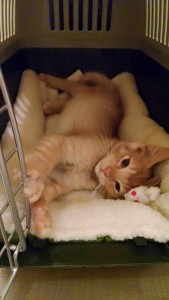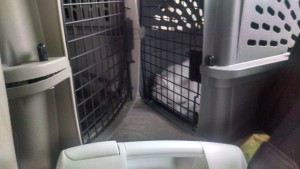At one time or another, most cat people will wind up making a long drive with kitty. But even for the most seasoned feline traveler, car rides are rarely fun. When you think about it, this is understandable: your cat was minding her own business when you suddenly put her into a box, then put that box into a bigger box that also moves, and then made her stay in the box for what seemed like an eternity, only to finally arrive at a place she didn’t want to go to in the first place. (Grandma’s house! Oh goody.) No wonder kitty is less than pleased about the whole thing. But whether your cat prefers to sit in huffy silence or serenade you with the song of her people for hours on end, know that it is possible to make this process safer for your cat and less stressful for you both.
Before you leave

- Set out the carrier. For many cats, carriers mean only one thing: the vet. Carriers appear right before kitty goes to the vet and disappear upon her return, so it’s no wonder such a negative association is created in your cat’s mind. However, with a little time, carriers can become a place of safety and comfort. To allow kitty to adjust to her carrier, be sure to set it out up to a week before your trip. Place a comfy blanket in the carrier and a few well loved toys, all of which will accompany her on your trip. With luck, she’ll begin to view the carrier as just another safe part of her territory.
- Choose the right carrier. For car travel, the carrier should be sturdy, well ventilated and large enough for the cat to stand and turn around in. You want it to be comfortable enough for the cat to feel secure, but tough enough to protect her in the event of an accident.
- Make sure kitty’s microchip, license and vaccinations are up to date. A missing cat is a nightmare. A missing cat on a long road trip is something much, much worse. Be sure that kitty’s microchip is registered with your correct information, that she is wearing a collar and tag at all times, and that her vaccinations are current, as some states have strict regulations about animal safety. Be sure to also write your contact information and any medical concerns (e.g., “Has heart disease and requires medication daily”) and affix this on the cat’s carrier should she become separated from you. In your own wallet, carry a card with your pet’s information and an emergency contact just in case you are incapacitated.
- Plan your route. Even with a GPS by your side, it is important to know where you’re traveling to and approximately how to get there. Nothing will exacerbate an already stressful situation like being lost, as kitty will pick up on your increasing frustration. For many cats, the absolute maximum amount of time they can spend in a car is 8 – 9 hours, although this could be less or more depending on the individual. Make reservations at pet-friendly hotels no more than 8 hours apart from one another and be sure to call to confirm that pets are allowed.
- Feed kitty 4 hours before leaving. Some cats have stomachs of steel, but most will vomit in a car like it’s their job due to the magical combination of stress and motion sickness. To help alleviate this, feed kitty 4 hours before beginning your journey. If leaving early in the morning, feed her right before you go to bed the night before. This will allow your cat time to digest her food.
Pack the car

- Feline travel bag. In the pandemonium of packing, don’t forget to pack a travel bag for your cat. This should include anything she might need in the car and when she arrives at her destination: food, water, medications (in a cooler, if necessary), vet records, first aid kit, litter and litter box (disposable if you will be unable to clean the box).
- Carrier placement: For the cat’s safety, carriers should be placed in the backseat only. If you do use the front seat, you must be sure that the passenger-side air bag is turned off. Ideally, carriers should be positioned to where the cats can see you and to where you can stick your fingers through the cage to comfort her. If possible, secure the carrier with either a harness or the seat belt so that it cannot roll in an accident; not only is this dangerous to your pets, but the carriers can become projectiles to you as well! Be mindful of the placement of the sun throughout the day; if it is beating down on the carrier, adjust her position so that kitty remains cooler.
- Pad the carrier with familiar scents. To help kitty’s stress levels, pad the carrier with a favorite blanket, t-shirt or something else that smells strongly of home. Just be sure she doesn’t overheat.
- Cleaning supplies. Messes are an inevitable part of life, so be sure to pack cleaning supplies that can be easily reached, including garbage bags, paper towels, non-toxic cleaner for your car, and an enzyme cleaner for pet mess clean up. Related to this: put a towel on the seats under the carrier… just in case.
On your way
- BE CALM! Your cat will pick up on your stress level, so be sure to keep road rage to a minimum. Speak softly and calmly to the cat. She will likely be talking up a storm, so it’s only polite to talk back to her. And be sure to keep the volume of your music low. Kitty is not interested in your singing voice.
- Do not leave your cat in a parked car alone. Every year, countless numbers of dogs and cats die from being locked in parked cars, where temperatures can rise quickly. If traveling with a friend, take turns leaving the car for bathroom and food breaks. If alone, it’s better to bring the cat carrier with you than risk both heat stroke and theft.
- Cat must be in the carrier at all times. I know, I know. Your cat is yowling and driving you crazy. She wants to leave her carrier so badly. Don’t do it. No exceptions: the safest place for your cat is in her carrier. In the event of an accident, a loose cat can be injured, killed or can escape. Cats have also wedged themselves into car seats, necessitating a costly extraction process. Basically: just don’t do it, okay?
- Sun and car temperature. Be mindful of the placement of the sun throughout the day; if it is beating down on the carrier, adjust her position so that kitty remains cooler. Also remember that the back seat can be much hotter than the front. Periodically check to make sure your cat is comfortable.
- Provide water. If you are on a long trip, give her a small dish of water when you’ve stopped for a break.
Your destination

- Hotel check. If staying in a pet-friendly hotel, ask for a room on the ground floor. This will make it easier to get the cat in and out of the hotel. Be sure to check the room for places the cat could escape to or get trapped in, including in the mattress or into a wall. Hang a “Do Not Disturb” sign on the door to alert all that the room is not to be entered.
- Base camp. Whether arriving at your final destination or a stop along the way, set up a base camp for your cat. This should include a litter box, their carrier, toys and familiar scents from home. If more than one room is available to her, confine the cat to one room while she gets acclimated to her new space.
- Food. Once settled, feed your cat. Nothing says “I love you / it’s all going to be OK” like food! Be sure to feed her the same food she has at home to avoid an upset stomach. If kitty doesn’t eat right away, just leave the food out; it may take some time for her to feel like eating after the harrowing day of being stuck in a box. However, more than 24 hours of not eating is a medical emergency that needs to be addressed by a vet.
Other
- One cat per carrier. We cannot stress this enough: unless the cats are itty bitty kittens, all cats must be in a separate carrier. Even best friends will fight when placed in an unfamiliar, stressful situation, and no one wants a cat fight breaking out in the backseat of a car!
- Monitor your pet for signs of distress. Some panting at the beginning of a car ride is usually normal; however, excessive and persistent panting, drooling, trembling or any other odd behavior can be an indication that something is very wrong. And related to that…
- Know the location of emergency vets along your route. Or have the ability to look them up. Hopefully you will not need one, but just in case, knowing where you are and how to get your animal help will save you a load of anxiety and may save your pet’s life.
- Other carriers. If the trip is a long one, you may consider using a large wire crate instead of a cat carrier so that you can place a litter box in the crate itself. If so, make sure that the floor of the wire cage is covered so that the cat can easily walk on it.
- Other stress relievers. For many cats, synthetic pheromones and Bach Flower Remedies, such as Rescue Remedy, can help alleviate some stress associated with car travel. Otherwise, sedatives are to be used only in extreme circumstances and only under the supervision of a veterinarian.
So best of luck to you and kitty on your road adventures! Remember that your cat’s safety is of the greatest importance. Do not let her pathetic wails from the back seat trick you into jeopardizing her well being. She will be fine. She is a road warrior.


















